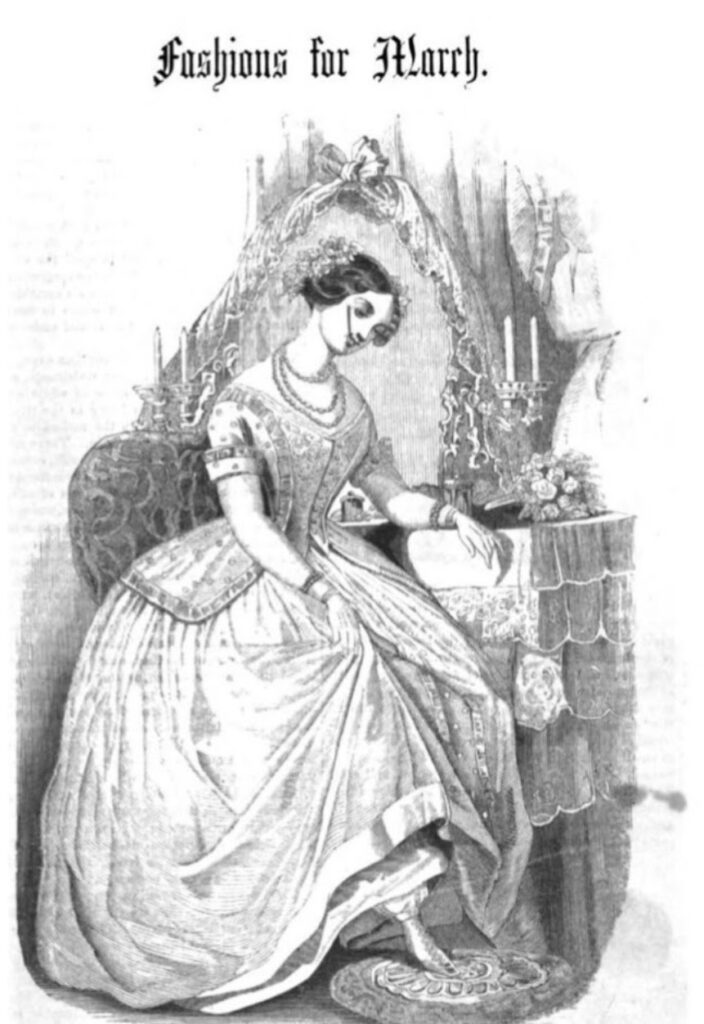As a fashion historian, I’m privileged to spend my time researching topics highly specific to my taste. While graduate school can be daunting, that’s the best perk—my research is truly mine! Though the topics you research are hyper-focused on your interests, I find that your curiosity will ultimately lead you to much more diverse paths than you realize. When you’re exposed to wonderful resources, you want to follow as many leads as you can. I certainly came into this program with a very niche interest—the portrayal of witches in the past was what I was sure would be my final thesis when I entered my program—but I found myself covering tons of equally interesting topics.
I’ve researched Halloween costumes and the evolution of plastic masks accompanying them over the years. Simultaneously, I studied a portrait of Henrietta Maria, a fashionable French queen who ruled alongside her husband in England. I loved writing this paper, as it focused on the century about which I originally planned on writing my thesis. I learned so much about Henrietta Maria and more importantly how intrinsic art is to my field. Not only are portraits rife with symbolism regarding status, temperament, and class, but the clothing cut, style, and color send an equally important message. Her portrait was the first of many pieces of art from the Met that I’ve researched. The others include a fashionable woman in the mid-19th century, whose clothing exemplified the popularity of romanticism in dress during that era, and a reliquary bust that held the remains of a saint.
Some of my other work includes an examination of the forgotten association of muslin dresses with illness and death. Thin, muslin dresses were all the rage for Victorian-era women’s formal wear. As they were thin and worn throughout the year, an association arose linking the inadequate coverage to falling ill and even dying. This perfect combination of macabre and fancy clothing made this paper one of my favorites. My other favorite paper is one that I wrote which focused on how stout—or in modern terms, plus-size—women navigated the flapper trend of the 1920s, which idealized thin bodies. I love contributing to underrepresented communities and researching the reality of what it was like for everyone who wasn’t a perfect example of the beauty standard.
No matter how niche a topic tickles my fancy, I follow the next step before writing or presenting my findings. Research, research, research! I always read classic history tomes that help contextualize the societies that produce the clothing I research. However, my field also relies on some pretty fun sources. I spend hours researching paintings, fashion plates, pictures, videos, magazine archives, short stories, and more. Research doesn’t have to be restricted to textbooks. Tons of unique sources are there waiting to be found! When I feel like I have enough information to back my hypothesis, I love to find ways to compile them into intriguing papers, using my words to guide my readers through my findings.
As I enter my final year of graduate school, my focus has entirely shifted to my thesis. I’m grateful for my diverse plethora of paper topics and how they changed me as a historian. Inspired by my paper on plus-size women in the 1920s, I am focusing my thesis on fatphobia in the early 2000s. I’m excited to continue researching this underrepresented group of women and hope to compile all my research into a book one day. While I have always loved history, finding the right lens through which to view it has made my life so much more interesting and exciting. If you’re interested in fashion history, I highly recommend looking at art, taking in media from the era you’re interested in, and reading what you can about that version of beauty standards. If fashion isn’t your thing, don’t worry! There are so many ways to study history from food to sports and everything in between.
For girls who are interested in fashion history, there are many avenues into the career! Many different fashion historians have many different backgrounds. Those who are passionate about the construction of clothing often come from a costume or fashion design background. Those who are more interested in the social side of fashion have backgrounds in history, like me. If the study of aesthetics is more your thing, a background in art history is the perfect foray into the subject! While many museums require degrees for their workers, many hobbyists are just as passionate and knowledgeable about the clothing of the past. Girls who want to pursue their passion outside of academia can look into historical societies, detailed Youtube channels, and the wide variety of books available! Pick a decade you love and research it–you’ll never know what rabbit hole you fall down. When I was a girl, I loved reading books like the Royal Diaries, the American Girl series, and The Time-Traveling Fashionista on Board the Titanic by Bianca Turetsky for exposure to different styles!
-Stephanie Ray
Junior Girl
Girl Museum Inc.

